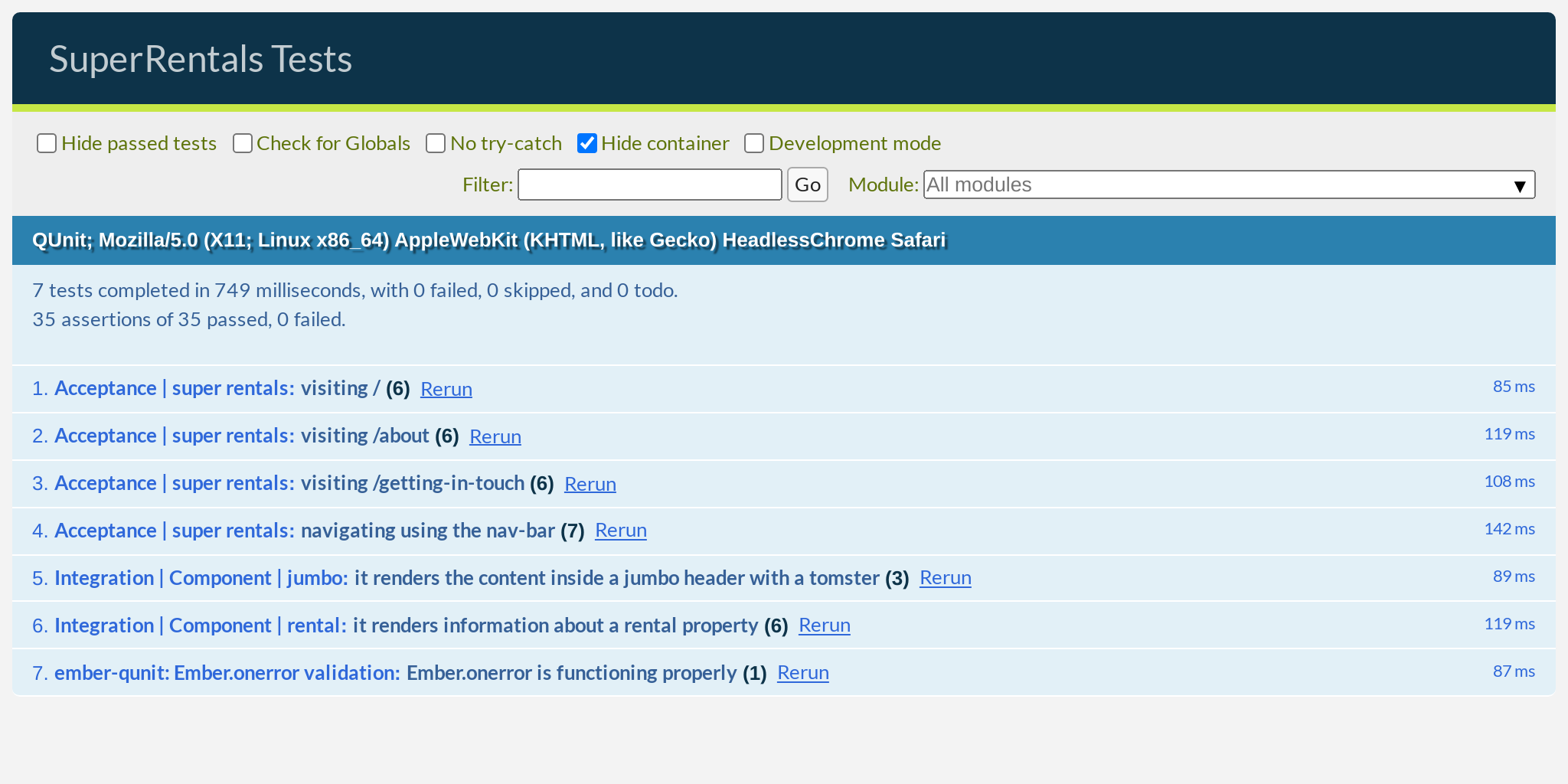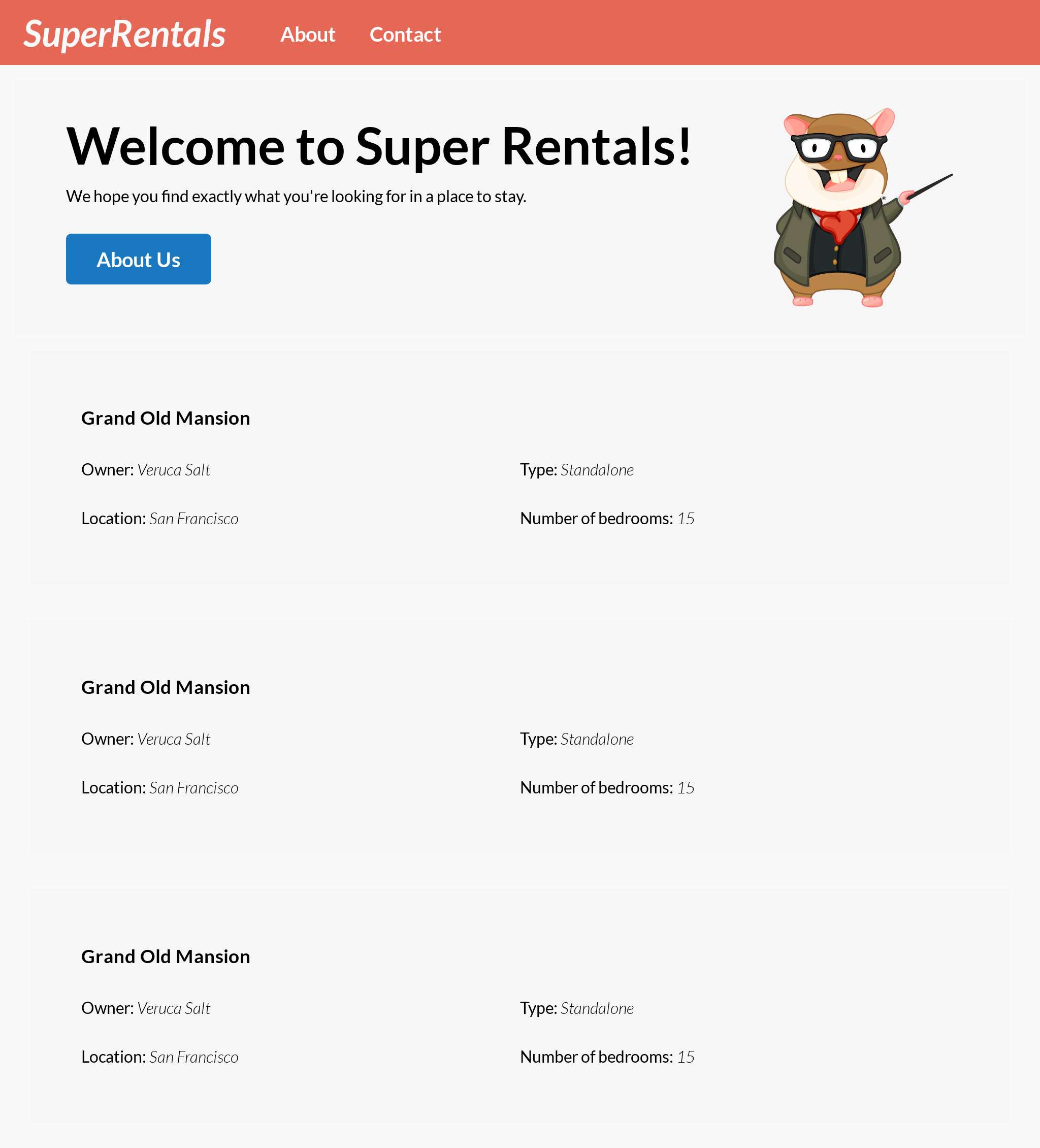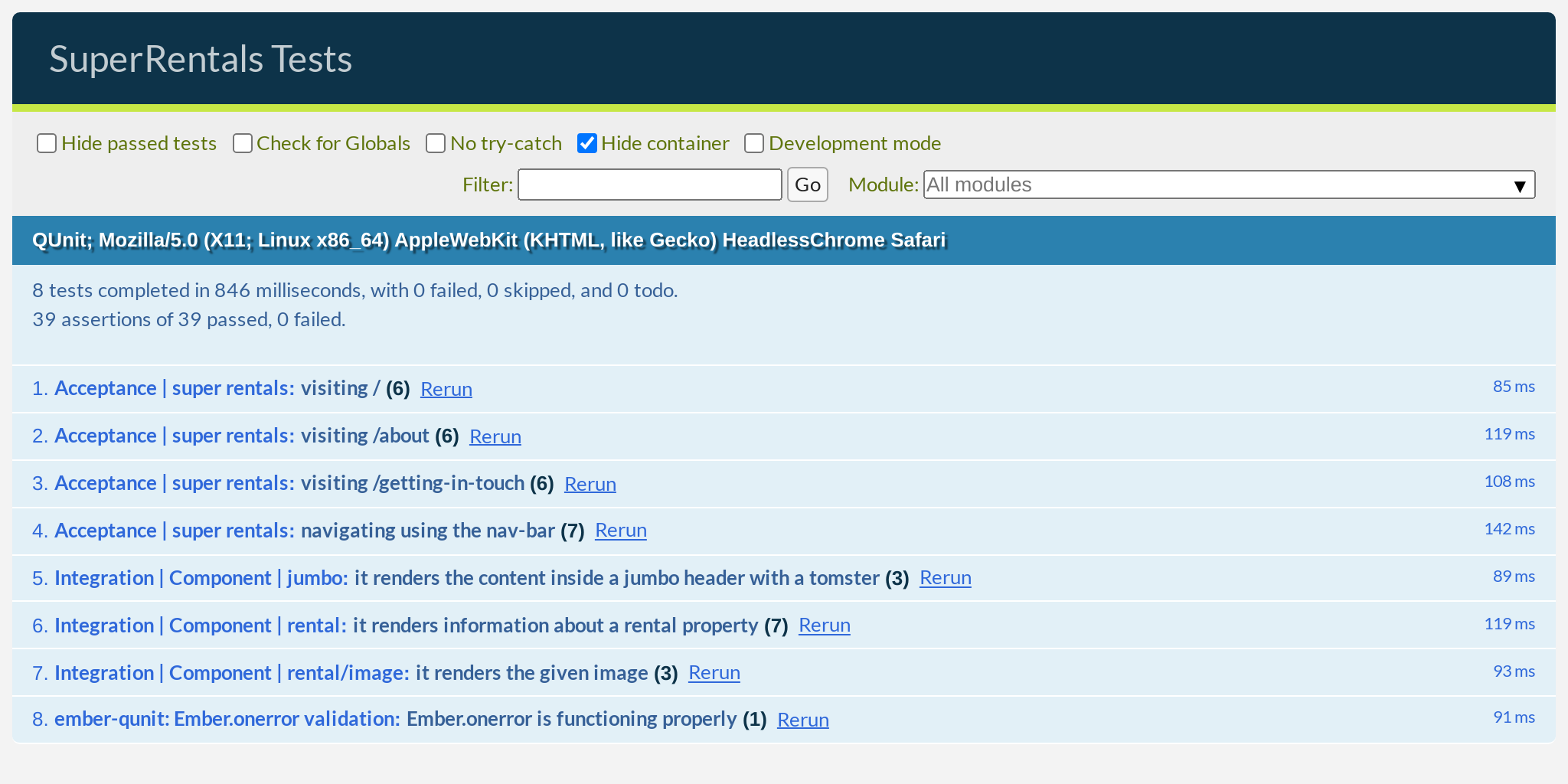It's time to finally work on the rentals listing:

While building this list of rental properties, you will learn about:
- Generating components
- Organizing code with namespaced components
- Forwarding HTML attributes with
...attributes - Determining the appropriate amount of test coverage
Generating Components
Let's start by creating the <Rental> component. This time, we will use the component generator to create the template and test file for us:
$ ember generate component rental
installing component
create app/components/rental.hbs
skip app/components/rental.js
tip to add a class, run `ember generate component-class rental`
installing component-test
create tests/integration/components/rental-test.jsThe generator created two new files for us, a component template at app/components/rental.hbs, and a component test file at tests/integration/components/rental-test.js.
We will start by editing the template. Let's hard-code the details for one rental property for now, and replace it with the real data from the server later on.
{{yield}}
<article class="rental">
<div class="details">
<h3>Grand Old Mansion</h3>
<div class="detail owner">
<span>Owner:</span> Veruca Salt
</div>
<div class="detail type">
<span>Type:</span> Standalone
</div>
<div class="detail location">
<span>Location:</span> San Francisco
</div>
<div class="detail bedrooms">
<span>Number of bedrooms:</span> 15
</div>
</div>
</article>Then, we will write a test to ensure all of the details are present. We will replace the boilerplate test generated for us with our own assertions, just like we did for the <Jumbo> component earlier:
import { module, test } from 'qunit';
import { setupRenderingTest } from 'ember-qunit';
import { render } from '@ember/test-helpers';
import { hbs } from 'ember-cli-htmlbars';
module('Integration | Component | rental', function(hooks) {
setupRenderingTest(hooks);
test('it renders', async function(assert) {
// Set any properties with this.set('myProperty', 'value');
// Handle any actions with this.set('myAction', function(val) { ... });
test('it renders information about a rental property', async function(assert) {
await render(hbs`<Rental />`);
assert.equal(this.element.textContent.trim(), '');
// Template block usage:
await render(hbs`
<Rental>
template block text
</Rental>
`);
assert.equal(this.element.textContent.trim(), 'template block text');
assert.dom('article').hasClass('rental');
assert.dom('article h3').hasText('Grand Old Mansion');
assert.dom('article .detail.owner').includesText('Veruca Salt');
assert.dom('article .detail.type').includesText('Standalone');
assert.dom('article .detail.location').includesText('San Francisco');
assert.dom('article .detail.bedrooms').includesText('15');
});
});The test should pass.

Finally, let's invoke this a couple of times from our index template to populate the page.
<Jumbo>
<h2>Welcome to Super Rentals!</h2>
<p>We hope you find exactly what you're looking for in a place to stay.</p>
<LinkTo @route="about" class="button">About Us</LinkTo>
</Jumbo>
<div class="rentals">
<ul class="results">
<li><Rental /></li>
<li><Rental /></li>
<li><Rental /></li>
</ul>
</div>With that, we should see the <Rental> component showing our Grand Old Mansion three times on the page:

Things are looking pretty convincing already; not bad for just a little bit of work!
Organizing Code with Namespaced Components
Next, let's add the image for the rental property. We will use the component generator for this again:
$ ember generate component rental/image
installing component
create app/components/rental/image.hbs
skip app/components/rental/image.js
tip to add a class, run `ember generate component-class rental/image`
installing component-test
create tests/integration/components/rental/image-test.jsThis time, we had a / in the component's name. This resulted in the component being created at app/components/rental/image.hbs, which can be invoked as <Rental::Image>.
Components like these are known as namespaced components. Namespacing allows us to organize our components by folders according to their purpose. This is completely optional—namespaced components are not special in any way.
Forwarding HTML Attributes with ...attributes
Let's edit the component's template:
{{yield}}
<div class="image">
<img ...attributes>
</div>Instead of hard-coding specific values for the src and alt attributes on the <img> tag, we opted for the ...attributes keyword instead, which is also sometimes referred to as the "splattributes" syntax. This allows arbitrary HTML attributes to be passed in when invoking this component, like so:
<article class="rental">
<Rental::Image
src="https://upload.wikimedia.org/wikipedia/commons/c/cb/Crane_estate_(5).jpg"
alt="A picture of Grand Old Mansion"
/>
<div class="details">
<h3>Grand Old Mansion</h3>
<div class="detail owner">
<span>Owner:</span> Veruca Salt
</div>
<div class="detail type">
<span>Type:</span> Standalone
</div>
<div class="detail location">
<span>Location:</span> San Francisco
</div>
<div class="detail bedrooms">
<span>Number of bedrooms:</span> 15
</div>
</div>
</article>We specified a src and an alt HTML attribute here, which will be passed along to the component and attached to the element where ...attributes is applied in the component template. You can think of this as being similar to {{yield}}, but for HTML attributes specifically, rather than displayed content. In fact, we have already used this feature earlier when we passed a class attribute to <LinkTo>.

This way, our <Rental::Image> component is not coupled to any specific rental property on the site. Of course, the hard-coding problem still exists (we simply moved it to the <Rental> component), but we will deal with that soon. We will limit all the hard-coding to the <Rental> component, so that we will have an easier time cleaning it up when we switch to fetching real data.
In general, it is a good idea to add ...attributes to the primary element in your component. This will allow for maximum flexibility, as the invoker may need to pass along classes for styling or ARIA attributes to improve accessibility.
Let's write a test for our new component!
import { module, test } from 'qunit';
import { setupRenderingTest } from 'ember-qunit';
import { render } from '@ember/test-helpers';
import { hbs } from 'ember-cli-htmlbars';
module('Integration | Component | rental/image', function(hooks) {
setupRenderingTest(hooks);
test('it renders', async function(assert) {
// Set any properties with this.set('myProperty', 'value');
// Handle any actions with this.set('myAction', function(val) { ... });
await render(hbs`<Rental::Image />`);
assert.equal(this.element.textContent.trim(), '');
// Template block usage:
test('it renders the given image', async function(assert) {
await render(hbs`
<Rental::Image>
template block text
</Rental::Image>
<Rental::Image
src="/assets/images/teaching-tomster.png"
alt="Teaching Tomster"
/>
`);
assert.equal(this.element.textContent.trim(), 'template block text');
assert.dom('.image').exists();
assert.dom('.image img').hasAttribute('src', '/assets/images/teaching-tomster.png');
assert.dom('.image img').hasAttribute('alt', 'Teaching Tomster');
});
});Determining the Appropriate Amount of Test Coverage
Finally, we should also update the tests for the <Rental> component to confirm that we successfully invoked <Rental::Image>.
import { module, test } from 'qunit';
import { setupRenderingTest } from 'ember-qunit';
import { render } from '@ember/test-helpers';
import { hbs } from 'ember-cli-htmlbars';
module('Integration | Component | rental', function(hooks) {
setupRenderingTest(hooks);
test('it renders information about a rental property', async function(assert) {
await render(hbs`<Rental />`);
assert.dom('article').hasClass('rental');
assert.dom('article h3').hasText('Grand Old Mansion');
assert.dom('article .detail.owner').includesText('Veruca Salt');
assert.dom('article .detail.type').includesText('Standalone');
assert.dom('article .detail.location').includesText('San Francisco');
assert.dom('article .detail.bedrooms').includesText('15');
assert.dom('article .image').exists();
});
});Because we already tested <Rental::Image> extensively on its own, we can omit the details here and keep our assertion to the bare minimum. That way, we won't also have to update the <Rental> tests whenever we make changes to <Rental::Image>.
